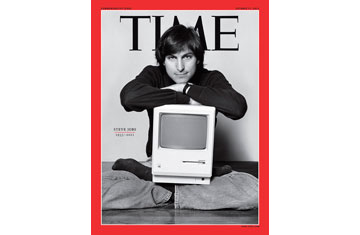
This article is not available for syndication, reprint or other use by third parties.
The saga of Steve Jobs is the Silicon Valley creation myth writ large: launching a start-up in the proverbial garage and building it into the world's most valuable company. He didn't invent many things outright, but he was a master at arranging ideas, art and technology in ways that repeatedly invented the future. He designed the Mac after appreciating the power of graphic interfaces in a way that Xerox was unable to do, and he created the iPod after grasping the joy of having a thousand songs in your pocket in a way that Sony, which had all the assets and heritage, never could accomplish. Some leaders push innovations by being good at the big picture. Others do so by mastering details. Jobs did both, relentlessly.
He revolutionized six industries: personal computers, animated movies, music, phones, tablet computing and digital publishing. You might even add a seventh: retailing, which Jobs did not quite revolutionize but did reimagine. Along the way, he produced not only transforming products but also, on his second try, a lasting company, endowed with his DNA, that is filled with creative designers and daredevil engineers who will carry forward his vision.
Jobs thus became the greatest business executive of our era, the one most certain to be remembered a century from now. History will place him in the pantheon right next to Thomas Edison and Henry Ford. More than anyone else of his time, he made products that were completely innovative, combining the beauty of poetry and the power of processors. With a ferocity that could make working with him as unsettling as it was inspiring, he also built what became, at least for a period this past month, the world's most valuable company. And he was able to infuse into its genetic code the design sensibilities, perfectionism and imagination that make it likely to be, even decades from now, the company that thrives best at the intersection of artistry and technology.
In the early summer of 2004, I got a phone call from him. He had been scattershot friendly to me over the years, with occasional bursts of intensity, especially when he was launching a new product that he wanted on the cover of TIME or featured on CNN, places where I'd worked. But now that I was no longer at either of those places, I hadn't heard from him much. We talked a bit about the Aspen Institute, which I had recently joined, and I invited him to speak at our summer campus in Colorado. He'd be happy to come, he said, but not to be onstage. He wanted, instead, to take a walk so we could talk.
That seemed a bit odd. I didn't yet know that taking a long walk was his preferred way to have a serious conversation. It turned out that he wanted me to write a biography of him. I had recently published one on Benjamin Franklin and was writing one about Albert Einstein, and my initial reaction was to wonder, half jokingly, whether he saw himself as the natural successor in that sequence. Because I assumed that he was still in the middle of an oscillating career that had many more ups and downs left, I demurred. Not now, I said. Maybe in a decade or two, when you retire.
But I later realized that he had called me just before he was going to be operated on for cancer for the first time. As I watched him battle that disease, with an awesome intensity combined with an astonishing emotional romanticism, I came to find him deeply compelling, and I realized how much his personality was ingrained in the products he created. His passions, demons, desires, artistry, devilry and obsession for control were integrally connected to his approach to business, so I decided to try to write his tale as a case study in creativity.
The unified field theory that ties together Jobs' personality and products begins with his most salient trait, his intensity. It was evident even in high school. By then he had begun his lifelong experiments with compulsive diets--usually only fruits and vegetables--so he was as lean and tight as a whippet. He learned to stare unblinking at people, and he perfected long silences punctuated by staccato bursts of fast talking.
This intensity encouraged a binary view of the world. Colleagues referred to the hero/shithead dichotomy; you were either one or the other, sometimes on the same day. The same was true of products, ideas, even food: something was either "the best thing ever" or it totally sucked. He could taste two avocados, indistinguishable to ordinary mortals, and declare one of them the greatest ever harvested and the other inedible.
He thought of himself as an artist, which instilled in him a passion for design. When he was building the original Macintosh in the early 1980s, he kept insisting that the design be "friendlier," a concept alien to computer-hardware engineers of the time. His solution was to make the front of the Mac look a little like a human face, and he even kept the plastic strip above the screen thin so it would not be a thick-browed Neanderthal's face.
